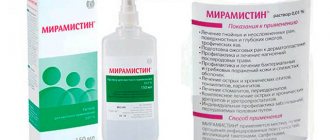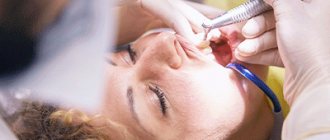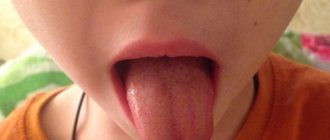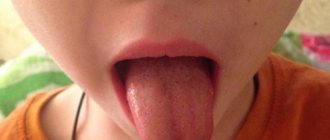Injuries to teeth and gums are common among children of all ages. If a child breaks a baby tooth, then first of all you need to remain calm and competently provide pre-medical care, while trying not to scare the baby. Most often, children are injured when they accidentally fall or when trying to chew hard food or an object. Therefore, children of primary preschool age, who are not yet accustomed to being careful, are most at risk; they may fall hard on the playground or injure their oral cavity with a foreign object.
Symptoms
To suspect that a child has broken a front tooth is quite simple:
- Violation of the shape and integrity of the dental crown. Upon examination, you may notice a chipped tooth and a defect;
- Appearance of a crack. Characteristic of an incomplete fracture, part of the tooth may wobble, but not break off;
- Strong pain. The pain can be localized in the tooth, gum, or even spread to the entire jaw, depending on the severity and nature of the injury. Pain in the jaw occurs with impacted fractures, which are most often the result of trauma. Young children who cannot say what happened begin to cry and refuse food;
- Swelling, redness, bleeding of the gums. In some cases, the fracture is also accompanied by injuries to the soft tissues of the oral cavity. In severe cases, pathological mobility of adjacent teeth may appear.
The child has a dislocated tooth, a severe bruise, and mobility.
In this case, the baby does not allow you to touch or put pressure on the tooth. The damaged unit makes it difficult to close the mouth. The pain is acute and does not go away without anesthetics.
Take your child to the clinic without delay. The dentist will take an x-ray to rule out damage to the roots and pulp. If the tooth remains in the socket, he will fix the position and apply a splint. When the tooth is completely knocked out, it will perform replantation (install it back into the hole). The pulp dies. But the implantation of a natural tooth is still better than its complete loss and replacement with an artificial one.
The root of a permanent tooth is broken.
Mostly the child complains of pain when biting or pressing on a tooth. Mobility and swelling of the gums appear. The fracture site is clearly visible on x-ray.
Therapy requires precise determination of the location of the fracture (upper, middle part, longitudinal fracture) and the presence of inflammation. Treatment methods depend on these parameters. As a last resort, we recommend tooth extraction. Before the procedure, the doctor, together with the parents, will decide how the empty area will be restored. A child's lost tooth can be replaced with a removable denture.
Prices for children's fillings and dental treatment
Features of dental restoration in children
Children's restoration is temporary, designed to last a couple of years until the bite changes. Since nothing should interfere with the proper growth and formation of permanent teeth.
For this reason, fixed dentures, crowns and veneers are not installed in children. They are limited to removable structures, they are easy to replace and adjust to the growing jaw.
At Idealdent, to restore a child’s tooth we use:
Removable prosthetics – plate dentures, butterfly dentures.
Young children are curious about dentures and quickly get used to them. They do not cause fear or psychological discomfort. Temporary orthopedic structures must be replaced every 8-10 months up to 10 years, and every year or two up to 18 years.
Removable dentures are good because:
- evenly distribute the load on the jaw;
- stimulate the development of bone tissue in toothless areas;
- maintain articulatory balance and smile aesthetics.
- Orthodontic treatment – preventive removable appliances with springs, sliding screws, bite pads and other elements.
Applicable at an early age. From 11-14 years old, braces are installed.
The braces system will allow you to correctly move your teeth and close the void. The duration of treatment depends on the clinical case. Usually, by the age of 16, jaw growth stops, braces remain, but the tactics for correcting the bite change.
Dental implantation in children.
Possible only after the final formation of the jaws by the age of 16-18.
What complications can there be?
The main complications of fractures of primary teeth are:
- Formation of a malocclusion (if a broken tooth has fallen out or been removed);
- Pulpitis. Damage to the enamel and tooth crown facilitates the penetration of pathogenic microorganisms into the pulp, where after some time an inflammatory process can develop;
- Periodontal abscess, phlegmon, osteomyelitis and other purulent complications. They are a consequence of advanced infection after tooth trauma.
If a child breaks his molar front teeth, it is important to make sure that the roots of the teeth are not damaged. Injury or fracture of the root of a permanent tooth is dangerous because the tooth may have to be removed from the roots, and expensive implantation will be required to restore the dentition.
A child's tooth chipped. What to do?
Most often, a child, especially a small one, gets a chip as a result of an impact accompanied by pain. What to do in such a situation?
- First of all, the child needs to be reassured;
- Next, a visual inspection and rinsing the mouth with water is required;
- If the lip is damaged, it should be treated with antiseptics;
- If there is a broken fragment, it must be placed in saline or milk;
- Visit the dentist as quickly as possible. This must be done within 24 hours, or preferably a few hours.
The faster a specialist sees a tooth, the greater the chance of its survival and absence of infections.
Today, there is a broad classification for dental injuries based on etiology and anatomy. The proposed classification is based on the standards of the World Health Association, and is included in the ICD Appendix in the “Dentistry” category.
How are they treated?
The dentist determines treatment tactics depending on the severity of the injury and the condition of the tooth. The following methods are used:
- Tooth restoration. Suitable only in cases where a small piece of the tooth has broken off and the pulp is not involved in the pathological process. Various types of composite materials are used to restore the integrity and normal appearance of the tooth;
- Depulpation. This procedure is used for more severe fractures when the child has symptoms of pulpitis. The process removes the infected pulp, which allows you to save the tooth and prevent the child from developing a malocclusion;
- Delete. A radical measure that is used in cases where it is no longer possible to save the tooth.
Tooth fracture exposing the pulp
This type of fracture is characterized by exposure of the pulp
X-ray
An X-ray reveals not only the absence of hard tissue fragments, but also a transformation in the shape of the periodontal fissure.
Biology
The pulp tissues are prone to healing and the creation of dentinal barriers, provided that the specialist uses the correct coating material. Direct pulp capping is most effective, and it is advisable to carry it out in the first hours after injury.
Among the most effective coating materials, it is necessary to highlight calcium hydroxide or mineral trioxide aggregate. Previous studies have shown that with their use, a dentinal bridge is successfully formed in 90% of cases.
Treatment
If a child's tooth breaks off and the pulp is exposed, it is possible to restore the hard tissue barrier only under certain conditions:
- The pulp was in normal condition before the injury;
- The blood supply to the pulp is not impaired;
- Using the direct coating method;
- No bacteria that can cause inflammation.
In conditions where the formation of the tooth root has not yet been completed, every possible effort must be made to preserve the pulp and the subsequent full development of the tooth root.
First aid
If you see a small chip on a tooth, but nothing bothers your child, then make an appointment with the dentist as planned. Many parents do not know what to do if their child breaks a front molar. Your actions should depend on the child's condition. If there is bleeding from the gums and severe pain, then you need to immediately go to the nearest dental clinic to see a doctor. If there is slight pain, but overall health is not affected, then you can give an anti-inflammatory drug (for example, paracetamol) in an age-appropriate dosage and make an appointment with a doctor the next day.
Injuries to baby teeth
Treatment of primary teeth plays an important role in dental health. Some moms and dads don't think so. This is a misconception. It is the strong temporary incisors, canines, and molars that are the foundation for the strength of the permanent masticatory organs. Therefore, therapy of temporary units must be carried out necessarily.
Mechanical damage varies in nature. They are:
- sharp
- chronic
The first group includes pathologies resulting from falls, impacts, and accidents. Injuries that have a chronic stage of development are associated with anomalies of the dental system and the habit of chewing hard objects. Because of this, the front milk tooth may suffer, as its tissues are injured. The unit may be damaged due to incorrect dental treatment due to the use of low-quality tools and equipment. Also, after removal of an organ, damage may remain. Injuries are classified into several types. This:
- Bruises
- Dislocations
- Fractures
In case of bruises, the structure of the crown is slightly damaged, its integrity is preserved. When the neurovascular bundle ruptures, the blood supply to the pulp is disrupted. The crown often becomes bluish. If there is no therapy, an inflammatory process develops. The child is constantly tormented by aching pain. After the examination, the dentist prescribes treatment:
- Protecting the pathological masticatory organ from stress for 15-20 days.
- The use of ointments and gels with an anti-inflammatory effect.
- Conducting electroodontodiagnosis, as well as radiography, to assess the condition of the pulp.
- Physiotherapy.
If a child breaks a front baby tooth, it may be a chip, crown fracture, or root fracture. For varying degrees of damage, different treatment technologies are used. When the fracture is complicated, visual inspection is not enough. For diagnosis, an electroodontic examination is performed, especially if a pulp defect is suspected. A radiograph is ordered to evaluate the unit's root canals. In such situations, therapy is recommended:
- The damaged enamel is polished and a filling can be placed, which reconstructs the anatomical shape of the unit.
- Serious crown pathologies require endodontic treatment or orthopedic measures.
- In case of slight injury to the root system, the problem is solved with a filling. Severe situations require removal of the anomalous unit.
If a child knocks out a baby tooth, it becomes mobile, falls out of its socket, and changes position in relation to other organs. Dislocations can be partial, complete, or impacted. In the first case, periodontal fibers are torn and the alveolar wall is damaged. Such units wobble, shift, and form bleeding periodontal pockets. When pressed, children experience severe pain. The dentist’s main task is to fix the organ in the socket using a mouth guard or splinting.
Complete rupture of the connective tissue leads to the organ falling out of the socket. If the bleeding is profuse, the baby will be hospitalized. If the parents see a doctor within an hour, the unit can be replanted. The parents can return the tooth to its socket. When this manipulation cannot be performed, the organ is placed in a bottle, filled with milk, and a doctor is immediately consulted. If a unit is lost, it is replaced with a prosthesis.
When the unit is buried in the socket, soft tissue swelling and bleeding are observed. In such a situation, reposition is used. Orthodontic therapy is sometimes performed. It happens that unformed units are cut through again. In any case, the child should be under the supervision of a pediatric dentist.
When is it necessary to install a crown?
Having a crown installed on an adult is common. But when a child needs a crown, parents are often scared. Meanwhile, crowns have a lot of advantages: they allow you to restore damaged areas of baby teeth lost due to complex caries or injury, they are aesthetically pleasing and inexpensive. We recommend installing crowns if:
- The tooth is significantly damaged, the child will not be able to fully chew food.
- The baby tooth has fallen out, and more than a year remains until the permanent one appears.
There are two types of crowns:
- Metal crowns with veneer made of composite material. These crowns are placed on the front teeth. They have an aesthetic appearance and protect the tooth from re-infection. Such crowns are not installed on chewing teeth, since the composite material often cannot withstand the chewing load.
- Metal crowns without veneer. Such crowns protect the tooth from infection, withstand the load of chewing, and even with the widest smile, are not noticeable to others. Currently, this material is considered the best for the restoration of baby teeth.
The use of such crowns allows a child’s tooth to be restored in one visit, which ensures the most comfortable treatment.
Why do chips appear on teeth?
Enamel is a durable transparent fabric. It reliably protects the tooth from destruction. However, there are a number of reasons why it may still break:
- eating too hard food
- mechanical injury (fall, blow)
- damage (cracks) in the enamel
- malocclusion
- untreated caries or incorrectly installed filling
- hypertonicity of the masticatory muscles
- partial absence of teeth, due to which the remaining ones are heavily overloaded
If a piece of a tooth breaks off, you need to seek help from a dentist, because over time, even a small chip can grow larger. The doctor will restore the beauty of your smile and comfortable eating, relieve psychological discomfort and increased sensitivity of teeth.
Types of dental damage
- Chip on the enamel.
Such an injury does not cause discomfort or unpleasant sensations, but can ruin the smile when it comes to the front tooth. - Chip within dentin.
This is damage to the layer that is located under the enamel. If such a chip is present, a short-term reaction to hot and cold, as well as sweet and sour, appears. If you do not immediately consult a dentist, dentin will further deteriorate, which can lead to complications in the form of pulpitis or periodontitis. - Chip to pulp.
If a large piece of a tooth breaks off, the pulp is damaged. This injury is accompanied by severe throbbing pain. Urgent dental care is needed, otherwise you may be left without a tooth. - The root of the tooth broke.
This type of fracture is a serious injury. But even in this case, the tooth can be saved from removal if you promptly seek help from a doctor. The sooner you do this, the more likely it is that the tooth will be saved.
There are different types of tooth damage, but regardless of the size of the chip, you need to seek help from a dentist. He will offer the right solution to restore the shape of the tooth, based on the situation.
Types of fractures and their causes
Depending on the specific characteristics of the defect, the following types of fractures are distinguished:
- Complete and incomplete. With a complete fracture, the pulp of the tooth is necessarily exposed, the canal is often exposed, and the root may be affected, but with an incomplete fracture, only the enamel and dentin are damaged.
- Transverse and longitudinal. A transverse fracture is more favorable in terms of subsequent recovery, especially if the lower (visible) third of the tooth has broken off. Longitudinal fractures are more complex; repairing a broken front tooth in such cases is almost impossible; it often has to be removed, especially if a large part of it is damaged.
- Comminuted fractures occur when there are several lines of damage. Such situations almost always require tooth extraction.
A fracture can affect both the crown of the tooth and the root itself. In the first case, diagnosis is not a problem, because all damage is visible to the naked eye. In order to see the root fracture, it is necessary to use an x-ray.
More often, a tooth fracture occurs when a mechanical force is applied to it. These are various types of injuries (accident, fight, fall). The degree of damage can vary: from a small chip of enamel on one tooth to injury to not only the front teeth, but also the molars.
It is not uncommon for enamel chips to occur when a hard object gets caught in food. In addition, the risk of breaking off a section of the tooth or the entire crown increases sharply if there are carious lesions. In this place, the integrity and, as a result, the strength of the entire tooth is compromised, so a fracture can occur even with a slight load.










